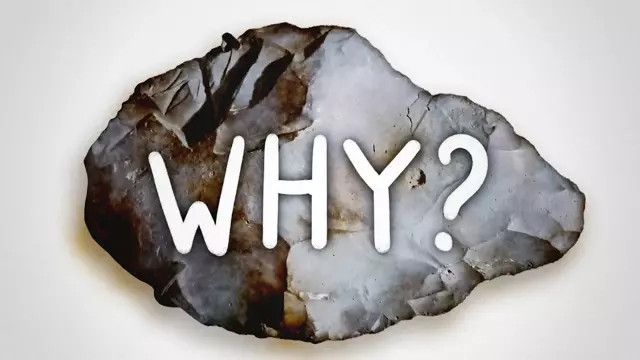2023-05-12
[public] 71.8K views, 32.5K likes, dislikes audio only
The Acheulean handaxe was the most common tool of early humans, but we still don’t know what the heck they used it for.
LEARN MORE
**************
To learn more about this topic, start your googling with these keywords:
- Acheulean handaxe: large, chipped stone objects which represent the oldest, most common, and longest-used formally-shaped working tool in human history.
- Microscopy: the technical field of using microscopes to view samples & objects that cannot be seen with the unaided eye.
- Microlith: small stone tool usually made of flint or chert and typically a centimeter or so in length and half a centimeter wide.
SUPPORT MINUTEEARTH
**************************
If you like what we do, you can help us!:
- Become our patron: https://patreon.com/MinuteEarth
- Our merch: http://dftba.com/minuteearth
- Our book: https://minuteearth.com/books
- Share this video with your friends and family
- Leave us a comment (we read them!)
CREDITS
*********
David Goldenberg | Script Writer, Narrator and Director
Lizah van der Aart | Illustration, Video Editing and Animation
Nathaniel Schroeder | Music
MinuteEarth is produced by Neptune Studios LLC
OUR STAFF
************
Lizah van der Aart • Sarah Berman • Cameron Duke
Arcadi Garcia i Rius • David Goldenberg • Melissa Hayes
Alex Reich • Henry Reich • Peter Reich
Ever Salazar • Leonardo Souza • Kate Yoshida
OTHER CREDITS
*****************
"Acheulean handaxe" photo by Mary Harrsch
https://www.flickr.com/photos/mharrsch/2501309147/
"Obsidian Microlith" photo by the Smithsonian
https://www.si.edu/object/obsidian-microlith:nmnhanthropology_8132133
OUR LINKS
************
Youtube | https://youtube.com/MinuteEarth
TikTok | https://tiktok.com/@minuteearth
Twitter | https://twitter.com/MinuteEarth
Instagram | https://instagram.com/minute_earth
Facebook | https://facebook.com/Minuteearth
Website | https://minuteearth.com
Apple Podcasts| https://podcasts.apple.com/us/podcast/minuteearth/id649211176
REFERENCES
**************
Rodriguez, Alice. (2023). Personal Communication. Department of Anthropology, NYU. https://as.nyu.edu/departments/anthropology/people/graduate-students/doctoral-students/alice-rodriguez.html
Iovita, Radu. (2023). Personal Communication. Department of Anthropology, NYU. https://as.nyu.edu/faculty/radu-iovita.html
Chang, M. (2009). The Case Against Sexual Selection as an Explanation of Handaxe Morphology. Paleoanthropology. https://paleoanthro.org/static/journal/content/PA20090077.pdf
Welsh, J. (2022). Tools May Have Been First Money. Live Science. https://www.livescience.com/18751-hand-axe-tools-money.html
Key, A J. M., Proffitt, T, Stefani, Elena and Lycett, Stephen J. (2016) Looking at handaxes from another angle: Assessing the ergonomic and functional importance of edge form in Acheulean bifaces. Journal of Anthropological Archaeology, 44 (Part A). pp. 43-55. https://kar.kent.ac.uk/57215/3/Key%20et%20al.%20Jul_30_2016_Handaxe%20edge%20angles.pdf
Iovita, R., McPherron, S.P., 2011. The handaxe reloaded: A morphometric reassessment of Acheulian and Middle Paleolithic handaxes. Journal of Human Evolution 61, 61–74. Retrieved from: https://doi.org/10.1016/j.jhevol.2011.02.007
Iovita, R., Tuvi-Arad, I., Moncel, M.-H., Despriée, J., Voinchet, P., Bahain, J.-J., 2017. High handaxe symmetry at the beginning of the European Acheulian: The data from la Noira (France) in context. PLOS ONE 12, e0177063. Retrieved from: https://doi.org/10.1371/journal.pone.0177063
Wayman. J.L. (2010) Foot Cutters: A New Hypothesis for the Function of Acheulian Bifaces and Related Lithics, Lithic Technology, 35:2, 171-194, Retrieved from: https://www.tandfonline.com/doi/abs/10.1080/01977261.2010.11721089
Sorensen, A.C., Claud, E. & Soressi, M. Neandertal fire-making technology inferred from microwear analysis. Sci Rep 8, 10065 (2018). https://doi.org/10.1038/s41598-018-28342-9
Aranda, V. et al. (2012) Experimental Program for the Detection of Use Wear in Quartzite. International Conference on Use-Wear Analysis: Use-Wear 2012.
Iovita, R., Sano, K. (Eds.), 2016. Multidisciplinary approaches to the study of Stone Age weaponry, Vertebrate Paleobiology and Paleoanthropology. Springer Netherlands, Dordrecht.
M. Dominguez- Rodrigo, J. Serrallonga, J. Juan-Tresserras, L. Alcala, L. Luque. (2001). Woodworking activities by early humans: a plant residue analysis on Acheulian stone tools from Peninj (Tanzania), Journal of Human Evolution, Volume 40, Issue 4. https://doi.org/10.1006/jhev.2000.0466
https://patreon.com/minuteearth
/youtube/video/DQVUuBQtb7w

